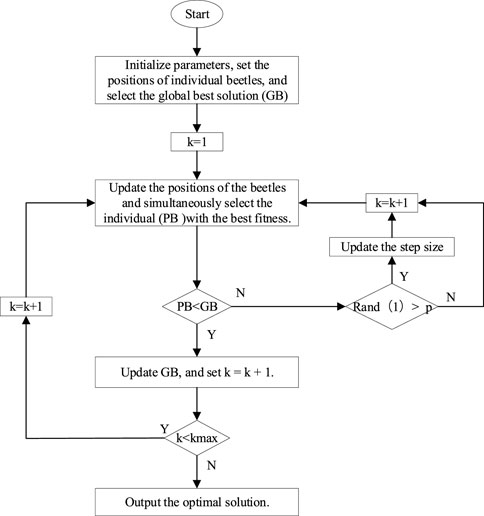- 1Hydroelectric Power and Water Resources Planning and Design Institute, Beijing, China
- 2PowerChina Hebei Electric Power Survey & Design Institute Co., Ltd, Shijiazhuang, China
- 3State Key Laboratory of Alternate Electrical Power System with Renewable Energy Sources, Baoding, China
To accelerate the green transformation of power grids, enhance the accommodation of renewable energy, reduce the operational costs of rural distribution networks, and address voltage stability issues caused by supply-demand fluctuations, this study proposes an optimization method for distributed energy storage systems in rural distribution networks integrated with renewable energy. Initially, the K-means clustering method is employed to analyze 1 year of load and renewable generation data, generating four typical scenarios to represent varying conditions of electricity supply and demand. Based on this analysis, a collaborative optimization model for energy storage and renewable energy-integrated distribution networks is constructed, comprehensively considering operational costs of the rural grid as well as the investment and operational costs of energy storage systems, with the objective of minimizing total operational costs. The optimal locations and capacities of energy storage systems are determined using YALMIP toolbox and the beetle swarm optimization (BSO) algorithm, and the proposed method is validated on a modified IEEE 33-bus system. The results demonstrate that the optimized energy storage planning significantly reduces the operational costs of the rural distribution network, decreases electricity purchasing expenses and curtailment losses of wind and solar energy, and optimizes power flow distribution while enhancing nodal voltage stability. This approach not only improves the economic efficiency and operational performance of rural distribution networks but also provides robust theoretical and technical support for the efficient utilization of renewable energy resources.
1 Introduction
As China continues to advance its green and sustainable development alongside the strategic “dual carbon” goals, a clean transformation and self-renewal of the power system characterized primarily by new energy sources such as wind and photovoltaic (PV) power are thriving (Liu et al., 2024; Jiang et al., 2025). The inherent nature of today’s grid is increasingly geared towards environmentally friendly power generation and efficient energy utilization. Distributed new energy sources are gradually being integrated into distribution networks. Unlike traditional centralized power systems, this approach involves directly connecting dispersedly arranged new energy sources to low-voltage distribution networks, offering advantages such as high flexibility, easy access, and relatively lower costs (Koushkbaghi et al., 2025). However, due to the volatility and significant time-sequence impact associated with wind and PV power generation, effectively addressing the mismatch between new energy consumption and grid regulation capabilities remains challenging. To tackle these issues, China places great emphasis on the development of energy storage technologies and has explicitly stated that it will consider the deployment of energy storage technology in the planning of new power systems (Zhao et al., 2025; Chu and Teng, 2023).
Energy storage systems have been widely applied in the planning and construction of modern power grids. They not only play a crucial role in “peak shaving and valley filling,” thereby reducing the impact of load fluctuations on grid voltage, but also effectively decrease curtailed energy, lower operational costs, and optimize grid performance. This leads to enhanced reliability and economic efficiency in power supply. Therefore, the rational planning of energy storage systems has become a key factor in ensuring the efficient and stable operation of distribution networks integrated with distributed new energy sources (Wang et al., 2025; Xiong et al., 2025; Zhang L. et al., 2025).
At present, most studies have focused on energy storage planning in distribution networks integrated with distributed generation. However, research on planning strategies specifically tailored for distribution networks incorporating renewable energy sources remains relatively limited (Ju et al., 2015). employed a deep reinforcement learning algorithm to propose a multi-time-scale energy storage planning strategy for distribution networks, which takes into account the characteristics of source-load power forecasting and the operational features of distributed generation (Ma et al., 2019). formulated a source-load-storage coordinated planning model for distribution networks aimed at minimizing operational costs, while considering different types of distributed generation and loads, thereby effectively reducing voltage violations in the distribution network (Zhang Z. et al., 2024). proposed a stochastic optimal battery energy storage planning method for dynamic distribution networks, determining the optimal capacity and location of energy storage. Since distributed generation typically does not exhibit the randomness and intermittency inherent in renewable energy generation, the aforementioned studies may face limitations in adaptability when applied to distribution networks integrated with distributed renewable energy sources.
Current research on energy storage planning remains insufficient in its analysis of economic costs, lacking a systematic consideration of multi-dimensional cost factors (Jia et al., 2018). conducted energy storage planning under reliability constraints and employed an algorithm to determine the installed capacity of energy storage devices. However, in their cost analysis, only operational costs of the distribution network were considered, without incorporating the corresponding life-cycle costs of the energy storage system (Ma et al., 2024). considered the temporal characteristics of photovoltaic (PV) output and its correlation with load demand in a distribution network integrated with distributed PV systems. They applied a simulated annealing algorithm to determine the optimal capacity of the energy storage system (Wu et al., 2018). proposed a centralized energy storage planning strategy suitable for a high-renewable-energy-dominated sending-end system. By employing a variational mode decomposition-based method, they optimized the siting and sizing of the energy storage system to ensure the safe and stable operation of the power system. With the widespread integration of distributed renewable energy into distribution networks, the impact of renewable energy curtailment costs should also be fully considered. Ignoring this factor may result in the investment and operational costs of the energy storage system exceeding the costs associated with renewable energy curtailment, thereby making it difficult to achieve optimal economic performance.
Compared to urban distribution networks, rural distribution networks typically exhibit characteristics such as low load density, long power supply radius, significant load fluctuations, and pronounced seasonality (Zhang J. et al., 2025). Currently, most research on energy storage planning has focused on urban distribution networks, while studies on the optimal configuration of energy storage systems in rural grid environments remain limited. It is therefore essential to conduct more targeted planning research based on the unique features of rural networks to enhance both their power supply reliability and operational economy.
In summary, although significant progress has been made in energy storage planning research in China, there is still a lack of in-depth exploration regarding the planning of energy storage systems in rural distribution networks (Zhang X. et al., 2024). At the same time, the analysis of the overall economic performance of distribution networks after renewable energy integration remains insufficiently comprehensive. This paper focuses on the optimal planning of energy storage systems within rural distribution networks integrated with distributed new energy sources, aiming to minimize the total operational cost of the distribution network. The proposed method enhances both the economic efficiency and voltage stability of the power system. Firstly, annual load and renewable generation data are clustered into four typical scenarios. Subsequently, a coordinated optimization model of the energy storage and new energy-integrated distribution network is established. The objective function is optimized using the YALMIP interface and Beetle Swarm Optimization (BSO) algorithm. Finally, the validity of the proposed energy storage planning approach is verified through simulations conducted in MATLAB, effectively balancing load response, economic performance, and environmental protection.
2 Temporal operation model of distributed new energy sources
At present, wind and photovoltaic (PV) power, as two major forms of distributed new energy sources, have been widely integrated into rural distribution networks in China. Due to the output characteristics of these energy sources being closely related to time sequences, significant variations in wind speed and solar irradiance across different time periods lead to considerable differences in power output from renewable generation units. Therefore, based on actual engineering data, this paper applies the K-means clustering algorithm to group the annual load, wind, and PV power data of the rural distribution network with distributed new energy sources into four typical temporal scenarios (Hao et al., 2024). The occurrence probability of each scenario is calculated, and the normalized data for each typical scenario are visualized, as shown in Figure 1.

Figure 1. (a) Typical scenario1 (b) Typical scenario2 (c) Typical scenario3 (d) Typical scenario4. Power distribution map of typical scenarios.
Each scenario illustrates the 24-h power variation patterns of load demand, wind power generation, and photovoltaic power generation. During certain operational periods, the total output from renewable energy units exceeds the power demand from the load side, resulting in curtailment of renewable energy. This not only leads to wastage of clean energy resources but also increases the operational cost of the distribution network. Hence, energy storage planning in such distribution networks serves a dual purpose: on one hand, it enables the storage of surplus electricity, thereby reducing grid operational costs; on the other hand, it facilitates large-scale integration of renewable energy sources, accelerating the green transition of the power grid.
3 Collaborative optimization model of energy storage and new energy-integrated distribution networks
3.1 Construction of the collaborative optimization model
The purpose of energy storage system planning is to store the surplus electricity generated during the process of new energy generation, thereby reducing the costs associated with curtailed wind and solar power, enhancing the economic efficiency of power system operation, and ultimately lowering the overall cost of distribution networks. Additionally, energy storage systems can perform peak shaving and valley filling, significantly decreasing voltage fluctuations in distribution networks during peak electricity usage periods, ensuring that the voltage at each node remains within a preset range, thus enhancing the stability of the power system.
Meanwhile, it is essential to consider the coordinated optimization between energy storage devices and the distribution network to achieve the minimization of total costs. Without such coordination, the operational costs of energy storage systems could exceed the costs associated with renewable energy curtailment, failing to improve the economic efficiency of the power system and potentially resulting in a counterproductive outcome. The objective function for this optimization can be formulated as follows:
In the formula,
The expression for the operational cost of the distribution network is as follows:
In the formula,
(1) cost of purchasing electricity from the higher-level grid
Where
(2) electricity network loss cost
Where
(3) interruptible load compensation cost
Where
(4) curtailment penalties of wind and solar power
Where
(5) renewable energy operation and maintenance cost
Where
The operational and maintenance cost expression for distributed energy storage systems is given by:
the calculation methods for each cost are as follows:
(6) annual fixed investment cost of the energy storage system
Where
(7) annual fixed investment cost of the energy storage system
Where
For the established objective function, the corresponding constraints are formulated as follows:
Constraint1: After configuring energy storage system in the renewable energy integrated distribution network, the system must satisfy the power flow balance constraint under steady-state conditions.
Where
Constraint2: The distribution network must satisfy the output constraints. Specifically, the active and reactive power input from the main grid to the distribution network must remain within their respective upper and lower bounds. Additionally, the active power delivered by distributed renewable energy sources to the grid, as well as the power of interruptible loads on the demand side, must also adhere to their corresponding upper and lower limits.
In the formula,
Constraint3: the power flow constraints of the distribution network must be satisfied.
Where
Constraint4: the constraints related to the energy storage devices must be satisfied, meaning that the charging and discharging power of each energy storage device is limited by its maximum power capacity and its own energy capacity. Additionally, the stored energy at any given time must remain within a reasonable range.
Where
3.2 Solving the collaborative optimization model
For the objective function constructed in Section 3.1, the model is a complex dynamic differential-algebraic equation, representing a nonlinear parameter optimization problem considering the power grid. It involves the optimization of multiple node-mounted synchronous condenser capacities, which is difficult to solve using classical mathematical programming methods. Considering computational speed and accuracy, and to ensure global search capability, the Beetle Swarm Optimization (BSO) algorithm is employed in this paper to solve the objective function.
The Beetle Swarm Optimization (BSO) algorithm is a novel optimization method that combines the advantages of both the Beetle Antennae Search (BAS) algorithm and the Particle Swarm Optimization (PSO) algorithm. It leverages their complementary strengths, offering high optimization efficiency and global search capability (Wu et al., 2024; Xuan and Li, 2024). In this algorithm, the initial beetle particles are generated through Monte Carlo random sampling. By incorporating an adaptive inertia weight adjustment strategy into the optimization iteration process, the population-based optimization process with a population size of Np is improved. In this population, the capacity of the synchronous condenser corresponds to the position of the beetles. In the
Where
Where
Where
First, the optimization problem is defined in YALMIP. Then, the beetle swarm is initialized, and the iteration count along with parameters is set. During each iteration, the position and velocity of each individual beetle are updated. The corresponding objective function value for each beetle is calculated using YALMIP, and the individual and global best solutions are updated accordingly. After multiple iterations, an approximate optimal solution is found, effectively solving the original problem. This approach combines the global search capability of the beetle swarm optimization (BSO) algorithm with the precise modeling and solving capabilities of YALMIP.
4 Rural distribution network case description
Based on the characteristics of the rural power grid system and referencing the IEEE 33-bus distribution network topology, wind and solar generation units are integrated at buses 1, 5, 12, 18, 22, 23, and 30. An example model of a distribution network with renewable energy sources is thereby constructed, as shown in Figure 3. The renewable energy power station includes both photovoltaic and wind power generation, which not only ensures diversity in renewable energy types but also effectively mitigates the intermittency issues associated with single-source generation through their complementary operation.
Referring to the current power market data in China, the unit cost of purchasing electricity from the grid
In practical engineering applications, it is often challenging to precisely match the ideal capacity values obtained through algorithmic optimization with the actual selected energy storage device capacities. Therefore, in real-world power system deployments, standardized capacity specifications are typically chosen for widely adopted energy storage devices, and their installation numbers are adjusted to ensure that the total installed capacity at each node aligns with theoretical calculations. This approach not only ensures the feasibility of implementation but also meets the precise requirements for energy storage capacity in system design (Li et al., 2024).
Thus, considering an annual depreciation rate
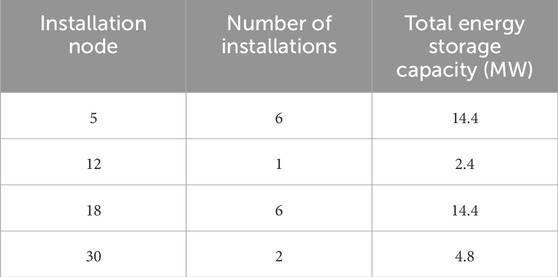
Table 1. The optimal planning scheme for distributed energy storage-based phase shifting transformers.
5 Rural distribution network case simulation
5.1 Economic analysis of rural distribution networks before and after energy storage planning
Based on the optimal planning scheme of distributed energy storage systems obtained in the previous section, the economic costs of each component of the rural distribution network before and after energy storage planning are presented in Table 2. By comparing the economic costs under both scenarios, the improvement in the economic performance of the rural distribution network with renewable energy integration after energy storage planning is analyzed.
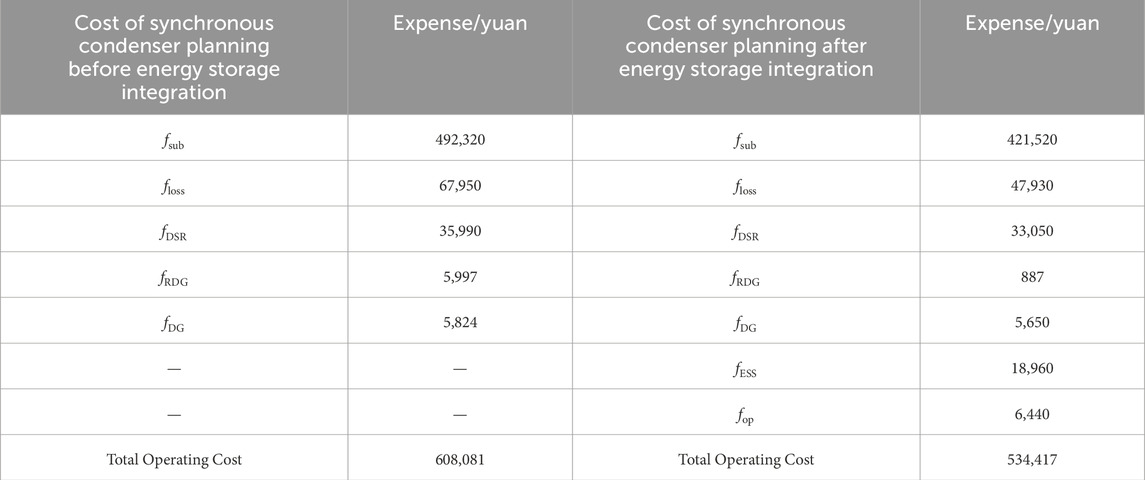
Table 2. Economic cost of distribution network before and after the planning of energy storage phase-shifting devices.
From Table 2, it can be observed that after implementing the distributed energy storage planning, the rural distribution network integrated with renewable energy demonstrates significant advantages in terms of economic performance, renewable energy accommodation capability, and operational efficiency. Most notably, the total operating cost of the distribution network is reduced by 681,400 RMB, approximately 11.4%, thereby enhancing overall economic benefits and highlighting the financial return capacity of energy storage-based compensators.
The energy storage system effectively reduces electricity procurement costs from the upper grid by storing surplus power during periods of excessive renewable generation and discharging during peak load times. This results in a cost reduction of 608,800 RMB, or about 12.6%. Furthermore, the system mitigates the variability of wind and solar power outputs, significantly reducing the waste of renewable energy and the associated economic losses caused by curtailed wind and solar generation. Specifically, after the implementation of energy storage planning, the penalty cost due to renewable curtailment decreases by as much as 85.4%, indicating that the energy storage system substantially improves the utilization rate of renewable energy generation and reduces resource wastage. At the same time, the integration of energy storage improves the power flow distribution within the grid, minimizes transmission losses, and reduces network loss costs to 26.5% of their original level, further enhancing the operational efficiency of the distribution network.
Therefore, implementing distributed energy storage planning for rural distribution networks incorporating renewable energy sources represents a crucial approach to achieving a balance between technical and economic considerations, as well as promoting environmental and social sustainability. In the short term, the integration of energy storage leads to significant reductions in electricity procurement costs, network losses, and renewable curtailment costs, thereby improving economic returns while markedly enhancing renewable energy utilization and grid operational efficiency. In the long run, energy storage planning not only enhances the grid’s capacity to integrate renewable energy but also reduces dependence on traditional fossil fuels, providing critical support for building a secure, economical, green, and reliable new power system. It also serves as an essential foundation for achieving national energy transition objectives.
5.2 Stability analysis of rural distribution networks before and after energy storage planning
By combining the node voltage data of the distribution network across different time periods before and after the implementation of distributed energy storage planning, this paper analyzes the improvement in voltage stability of the rural distribution network integrated with renewable energy. Under four typical scenarios, the voltage stability at each node is effectively enhanced, with generally similar results. Therefore, this study only presents the voltage profile comparisons before and after planning for two representative scenarios, while the others are omitted for brevity. The voltage curves of the distribution network before and after distributed energy storage planning under Scenario one and Scenario 2 are illustrated in Figures 4, 5, respectively.
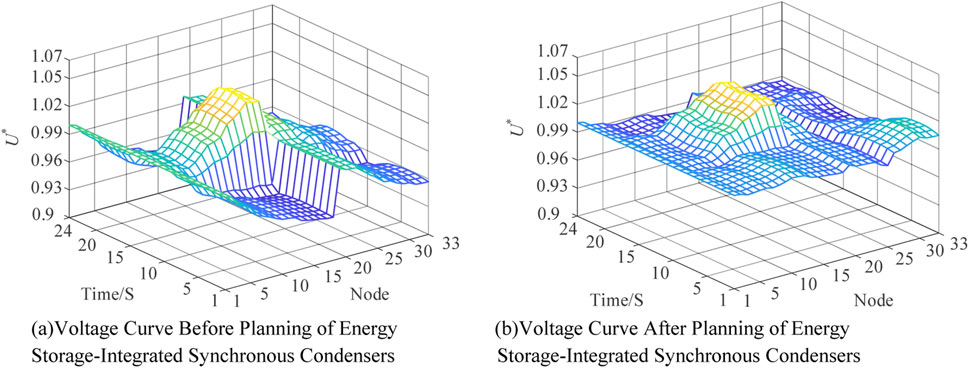
Figure 4. (a) Voltage curve before planning of energy storage-integrated synchronous condensers. (b) Voltage curve after planning of energy storage-integrated synchronous condensers. Comparison of voltage curves in typical scenario 1.
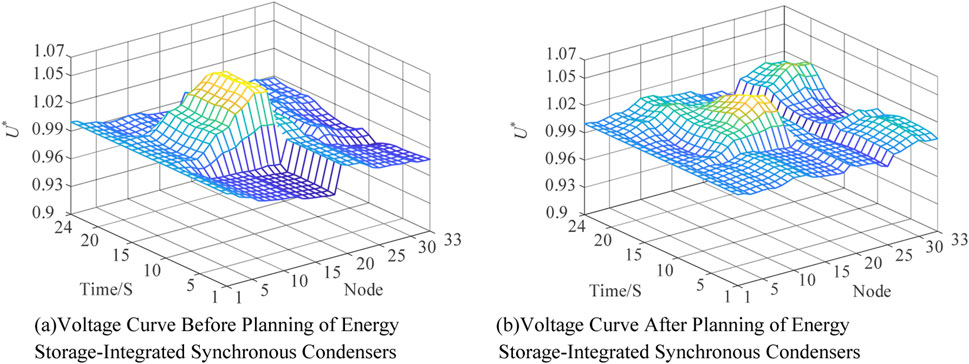
Figure 5. (a) Voltage curve before planning of energy storage-integrated synchronous condensers. (b) Voltage curve after planning of energy storage-integrated synchronous condensers. Comparison of voltage curves in typical scenario 2.
In the three-dimensional voltage profile graphs, deeper colors indicate a greater deviation from the baseline voltage values. Prior to the implementation of distributed energy storage planning, node voltages across the distribution network exhibited significant fluctuations during various time periods, especially during midday and evening peak hours when power demand was high, leading to noticeable voltage drops or rises at some nodes. During off-peak hours, voltage levels notably decreased, with some nodes even falling below the lower voltage limit of 0.95, thus increasing voltage variability within the grid and posing challenges to the stable operation of the distribution network.
After the introduction of distributed energy storage, the overall voltage profiles became smoother, with significantly reduced voltage differences between nodes and substantially diminished voltage fluctuations. By discharging during peak load times and absorbing excess power during off-peak times, the energy storage systems effectively balanced system power, mitigating voltage imbalances caused by load fluctuations. Moreover, the amplitude of voltage fluctuations over time was markedly reduced, bringing node voltage values closer to the nominal voltage (1.0) without any significant voltage dips, thereby enhancing the voltage stability of the system. The introduction of such composite devices not only avoids the issue of unstable voltage fluctuations that can occur with energy storage systems alone but also precludes the need for additional reactive power compensation equipment to address this deficiency. This demonstrates that these devices optimize both the economy and operational efficiency of the distribution network.
6 Conclusion
This paper proposes a coordinated optimization planning method for energy storage systems and distribution networks in rural power grids with distributed renewable energy. A collaborative optimization model was established to minimize the total operating cost of the distribution network, achieving economic optimality by comprehensively considering various cost factors. The optimal energy storage configuration scheme was solved using the YALMIP toolbox and the Beetle Swarm Optimization (BSO) algorithm. Simulation results demonstrate that the proposed method exhibits significant advantages in terms of economic efficiency, renewable energy accommodation, and voltage stability, as detailed below:
1) Economic performance improvement: After energy storage planning, the total operation cost of the rural distribution network decreased from 5.9665 million CNY to 5.2851 million CNY, representing an 11.4% reduction. Specifically, the electricity purchase cost decreased from 4.8293 million CNY to 4.2205 million CNY, the wind/solar curtailment penalty cost dropped from 0.0609 million CNY to 0.0089 million CNY, and the network loss cost was reduced from 0.6579 million CNY to 0.4833 million CNY.
2) Enhanced renewable energy utilization: By flexibly dispatching redundant power through the energy storage system, the wind/solar curtailment penalty cost is reduced by 85.4%, indicating a substantial improvement in renewable energy utilization efficiency.
3) Improved voltage stability: After energy storage planning, node voltage fluctuations were significantly reduced. Under typical scenario 1 and scenario 2, the voltage profiles at all nodes became smoother and closer to the rated value of 1.0 p.u., demonstrating enhanced voltage stability.
4) Feasibility for engineering implementation: The use of standardized energy storage capacities, such as 14.4 MW and 4.8 MW, enables meeting theoretical requirements by adjusting the number of installations, thereby ensuring practical feasibility for engineering applications.
In conclusion, the proposed method demonstrates strong practical application value in improving distribution network efficiency, reducing renewable energy curtailment, and promoting the transition toward green and sustainable energy systems.
Data availability statement
The raw data supporting the conclusions of this article will be made available by the authors, without undue reservation.
Author contributions
HoJ: Conceptualization, Data curation, Investigation, Supervision, Writing – original draft, Writing – review and editing. RF: Data curation, Methodology, Supervision, Writing – original draft. HiJ: Data curation, Formal Analysis, Methodology, Writing – original draft. CG: Data curation, Formal Analysis, Validation, Writing – original draft. YZ: Formal Analysis, Software, Supervision, Writing – review and editing. RZ: Data curation, Methodology, Software, Supervision, Writing – review and editing. ZX: Data curation, Software, Validation, Writing – original draft, Writing – review and editing.
Funding
The author(s) declare that financial support was received for the research and/or publication of this article. This work is supported by the National Natural Science Foundation of China (62303183) and the Science and Technology Project Fund of Hydroelectric Power and Water Resources Planning and Design Institute (ZY-KJXN-20230010).
Acknowledgments
The authors would like to express their sincere gratitude for the financial support.
Conflict of interest
Authors RF, CG, and RZ were employed by PowerChina Hebei Electric Power Survey & Design Institute Co., Ltd.
The remaining authors declare that the research was conducted in the absence of any commercial or financial relationships that could be construed as a potential conflict of interest.
Generative AI statement
The author(s) declare that no Generative AI was used in the creation of this manuscript.
Publisher’s note
All claims expressed in this article are solely those of the authors and do not necessarily represent those of their affiliated organizations, or those of the publisher, the editors and the reviewers. Any product that may be evaluated in this article, or claim that may be made by its manufacturer, is not guaranteed or endorsed by the publisher.
References
Chu, Z., and Teng, F. (2023). Voltage stability constrained unit commitment inpower systems with high penetration of inverter-based generators. IEEE Trans. Power Syst. 38, 1572–1582. doi:10.1109/TPWRS.2022.3179563
Hao, L., Lu, X., Ding, Y., and Jin, K. (2024). Optimal allocation strategy for renewable energy-grid-user-side energy storage considering capacity sharing. Proc. CSEE. 44, 5607–5620. doi:10.13334/j.0258-8013.pcsee.230971
Jia, Q., Zhao, M., Sun, L., Du, G., Fan, J., and Sun, H. (2018). Planning for grid-connection of distributed PVs considering the sequential feature and correlation in active distribution network. Proc. CSEE. 38, 1719–1728. doi:10.13334/j.0258-8013.pcsee.170782
Jiang, Y., Zhao, S., and Wang, H. (2025). Distributionally robust frequency constrained unit commitment with frequency support of wind power and synchronous condenser. Trans. China Electrotech. Soc. 40, 80–95. doi:10.19595/j.cnki.1000-6753.tces.232164
Ju, L. W., Yu, C., and Tan, Z. F. (2015). Two-stage dispatching optimization model and solution algorithm for wind power energy storage considering demand response. Power Syst. Technol. 39, 1287–1293. doi:10.13335/j.1000-3673.pst.2015.05.018
Koushkbaghi, S., Chen, Z., Amani, A. M., Jalili, Z., and Yu, X. (2025). Resilient distributed secondary control of battery energy storage systems in islanded microgrids. IEEE Trans. Ind. Cybern. Phys. Syst. 3, 408–418. doi:10.1109/TICPS.2025.3572887
Li, J., Fang, Z., Wang, Q., Zhang, M., Li, Y., and Zhang, W. (2024). Optimal operation with dynamic partitioning strategy for centralized shared energy storage station with integration of large-scale renewable energy. J. Mod. Power Syst. Clean. Energy. 12, 359–370. doi:10.35833/MPCE.2023.000345
Liu, H., Jia, K., Bi, T., Niu, H., and Li, W. (2024). Low Voltage ride through methods for flexible DC converter stations connected to the gathering system of new energy base. Trans. China Electrotech. Soc. 40, 759–770. doi:10.19595/j.cnki.1000-6753.tces.240025
Ma, H., Wang, B., Gao, W., Liu, D., Sun, Y., and Liu, Z. (2019). Optimal scheduling of an regional integrated energy system with energy storage systems for service regulation. Autom. Electr. Power Syst. 11, 195–46. doi:10.3390/en11010195
Ma, X., Xue, F., Gu, W., Li, H., and Lu, S. (2024). An optimization method for the configuration of grid-type energy storage and distributed phase shifters considering the short-circuit ratio constraints of multiple substations. Power Autom. Equip., 1–9. doi:10.16081/j.epae.202412006
National bureau of statistics (2023). China energy statistical yearbook. Beijing: China Statistics Press.
Wang, H., Bai, C., Wang, Z., and Roychowdhury, R. (2025). Resilient preparation and restoration strategy for integrated electric-gas distribution systems considering mobile energy storage. IEEE Trans. Smart Grid 16, 1127–1141. doi:10.1109/TSG.2025.3526778
Wu, D., Li, G., Javadi, M., Malyscheff, A. M., Hong, M., and Jiang, J. (2018). Assessing impact of renewable energy integration on system strength using site-dependent short circuit ratio. IEEE Trans. Sustain. Energy. 9, 1072–1080. doi:10.1109/TSTE.2017.2764871
Wu, Y., Sun, D., Zhang, M., Zhao, J., and Wu, H. (2024). Beetle swarm with constrained lévy flight for image matching. IEEE Trans. Autom. Sci. Eng. 22, 3366–3376. doi:10.1109/TASE.2024.3393897
Xiong, Z., Shen, X., and Sun, H. (2025). Two-stage robust planning for park-Level integrated energy system considering uncertain equipment contingency. IEEE Trans. Smart Grid 16, 1112–1126. doi:10.1109/TSG.2024.3524879
Xuan, Z., and Li, Y. (2024). “Research on optimal allocation of distributed synchronous condensers in high-proportion photovoltaic sending-end systems,” in J. North China electr. Power univ. (Natural Science Edition) 10. Beijing, China: Nat. Sci., 1. Available online at: http://kns.cnki.net/kcms/detail/13.1212.TM.20241204.1443.002.html.
Zhang, J., Ji, Y., Zhou, J., Jia, Y., Shi, G., and Wang, H. (2025b). Cooperative AC/DC voltage margin control for mitigating voltage violation of rural distribution networks with interconnected DC link. IEEE Trans. Power Del. 40, 1014–1029. doi:10.1109/TPWRD.2025.3535712
Zhang, L., Zhang, H., Li, F., and Sun, B. (2025a). Bi-level optimal design of integrated energy system with synergy of renewables, conversion, storage, and demand. IEEE Trans. Ind. Appl. 61, 2170–2181. doi:10.1109/TIA.2024.3524950
Zhang, X., Zhang, G., and Yu, S. (2024a). Review of control techniques for interleaved buck converters: control strategies, efficiency optimization and phase shedding. Chin. J. Electr. Eng. 11, 40–58. doi:10.23919/CJEE.2025.000108
Zhang, Z., Zhou, M., Guo, Z., Wu, S., Chen, Y., and Li, G. (2024b). Robust planning method for transmission grid and energy storage coordination considering dynamic thermal rating of overhead lines. Proc. CSEE. 1–14. Available online at: http://kns.cnki.net/kcms/detail/11.2107.tm.20240401.1022.002.html.
Keywords: rural distribution network, distributed energy storage, collaborative optimization, voltage stability, renewable energy accommodation, beetle swarm optimization
Citation: Jia H, Feng R, Jiang H, Gao C, Zhao Y, Zhang R and Xuan Z (2025) Research on energy storage planning methods for distributed renewable energy integrated rural power distribution networks. Front. Energy Res. 13:1640375. doi: 10.3389/fenrg.2025.1640375
Received: 03 June 2025; Accepted: 26 June 2025;
Published: 17 July 2025.
Edited by:
Zhijian Hu, Laboratoire d’analyse et d’architecture Des Systèmes (LAAS), FranceReviewed by:
Zhaoyan Zhang, Hebei University, ChinaHatem Seoudy, El Shorouk Academy, Egypt
Zhen Fan, Eversource Energy Boston, United States
Copyright © 2025 Jia, Feng, Jiang, Gao, Zhao, Zhang and Xuan. This is an open-access article distributed under the terms of the Creative Commons Attribution License (CC BY). The use, distribution or reproduction in other forums is permitted, provided the original author(s) and the copyright owner(s) are credited and that the original publication in this journal is cited, in accordance with accepted academic practice. No use, distribution or reproduction is permitted which does not comply with these terms.
*Correspondence: Haoshuai Jia, MTI2Mzc1OTU0OUBxcS5jb20=
 Haoshuai Jia
Haoshuai Jia Renqing Feng2
Renqing Feng2